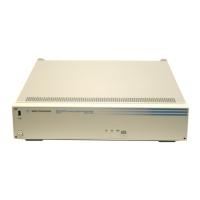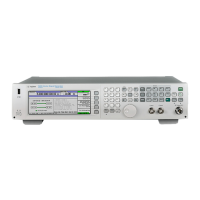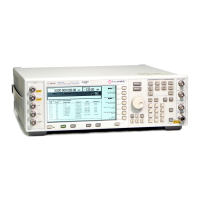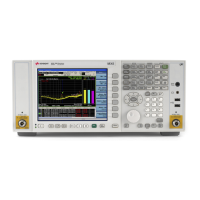Agilent N5161A/62A/81A/82A/83A MXG Signal Generators Service Guide
Troubleshooting
Troubleshooting the RF Path (N5161A/62A/81A/82A)
1-68
3. Using Table 1-10, re-check the maximum power levels.
— If the signal generator meets its maximum power levels, proceed to “Troubleshooting the RF Path (N5161A/62A/81A/82A)” on
page 1-68.
— If the signal generator does not achieve the maximum power levels:
a. Replace the A2 Vector Module assembly.
b. Proceed to “Troubleshooting the RF Path (N5161A/62A/81A/82A)” on page 1-68.
• If the signal generator is an N5183A and it does not meet one or more of the listed power levels in Table 1-12, perform the
troubleshooting procedure for the frequency range in which the low power occurred:
— “No Output Power or Output Power is Unleveled (N5183A)” on page 1-40
— “Low Output Power or No Output Power < 3.2 GHz (N5183A)” on page 1-41
— “Low Output Power or No Output Power >= 3.2 GHz (N5183A)” on page 1-46
Troubleshooting the RF Path (N5161A/62A/81A/82A)
The ALC loop circuitry is part of the A3 RF assembly. It is likely an unleveled or under power condition is the result of a problem with the
A3 RF assembly.
• For an N5161A/81A signal generator, replace the A3 RF assembly.
• For an N5162A/82A signal generator,
1. Verify that the A2 Vector Module is not contributing to the unleveled or under power condition. Refer to
“A2 Vector Module Troubleshooting (N5162A/82A Only)” on page 1-29.
2. If the A2 Vector Module is not contributing to the condition, replace the A3 RF assembly.
Troubleshooting the 6 GHz Electronic Attenuator (N5161A/62A/81A/82A)
The 6 GHz electronic attenuator is built into the A3 RF assembly. It has an attenuation range of 130 dB, in 5 dB steps. The attenuator is used
to rough tune the power level, while the ALC loop is used to fine-tune the power level. (The ALC fine tunes the power level within each
5 dB step.) Due to the interactive design of the attenuator and the ALC loop, there is no precise setting that will predict when the attenuator
will be switched in. The firmware, along with the selected frequency, the current ALC setting, modulation, and the requested attenuation all
work together to determine the optimum instrument performance and when an attenuation step is switched in.
Aside from an A1 Power Supply failure, any suspected improper functionality of the attenuator requires the replacement of the A3 RF
assembly.
The best way to troubleshoot the 6 GHz Electronic Attenuator is to run self test “601 Attenuator Voltages”. If this self-test cannot be run,
perform the following steps:
1. Refer to Figure 1-30. Use a voltmeter with a small probe to measure the output voltage +5.1V at J10-F23 and +/-15V at J10-A1 and
J10-A3 on the A3 RF assembly.

